The Summer Of Our Discontent
By Javed Iqbal
25 June, 2010
Moon Chasing Blog
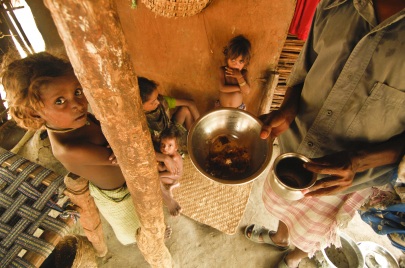
Madvi Hidme of the IDP settlement of Kamantome
in Khammam district can only manage to feed his
three daughters Laxmi, Anita and Parmila a
little rice with some imli.
Summer 2010, and it is becoming evidently clear that the adivasi refugees from the Maoist-Salwa Judum conflict in Dantewada, residing in Khammam district have either no access to water nor food. There are an estimated 16,024 IDPs identified in 203 settlements in Khammam district alone with a 110 settlements in the Reserve Forest. At the same time, the Forest Department is struggling to prevent the clearing of forests by the IDPs for podu cultivation.
Kamantome
There was a dead scorpion in their only source of drinking water – a miasmic well dug into the dry riverbed adjacent to their IDP village of Kamantome in Khammam District of Andhra Pradesh. Four Adivasis in their village were already sick, everyone suffers from rashes, no one has any work, barely any food – all they eat is a little rice with imli.
Kovasi Santo (6 years) has been lying in bed all week, barely eats and barely talks and his mother Maasa doesn’t know what to do. No doctor has visited them yet.
Shamala Idma can’t work, can’t get out of bed, complains of pain in his stomach and vomiting. Two other men complain of similar symptoms. One man has malaria. They all say they started to fall sick when they started to drink that water.
In November 2009, the Child Rights Commission had recommended that handpumps be built in the village of Kamantome but there are still no handpumps as of the 31st of May, 2010, as the temperature regularly crosses the 47 degree Celsius mark, and is slowly and infamously being recognized as one of the cruellest summers in recent time.
Kamantome started as a settlement for Gotti Koyas or Murias when they migrated from Chhattisgarh for land, and to escape the Salwa Judum-Maoist conflict. Their homes were broken down by the Forest Department in 2005 yet they returned a few years later.
Eventually, an encounter would take place in 2009, one tribal would be killed as an alleged Maoist, two would be arrested and booked under Andhra Pradesh Public Security Act. Both would be eventually released. One of them, Madvi Hidme, now with his three infant daughters in Kamantome recollects how his hands were tied behind his back, hung by the ceiling and then beaten and interrogated in Badrachalam police station for information on the Maoists.
Truth is, the police had acted on an evidently erroneous tip-off received from the neighbouring village of Ramchandrapurum that is also native to Gotti Koyas, with whom the villagers of Kamantome are in constant conflict over, owing to the limited resources available in the jungle. In Ramchandrapurum, Maoists had killed two people earlier. It has a handpump (built by missionaries) and is over a kilometre away from the village of Kamantome. It may be the closest handpump to Kamantome but the villagers will never go to it.
They spend all their days trying to beat the heat, as no work is available to them. They received NREGS cards and all the villagers last received their payments in April. Kunjam Deva worked to receive a payment of Rs. 1038 on the 22nd of April. All the money he received was used to repay loans he took last year to buy rice for his family. Of the 20 families in Kamantome, this pattern is repeated. And now they have very little rice left for this year and no money and no work.
‘Even if we have work, what’s the point as there is no water?’ Said Madkam Mulaiya s/o Ganga. ‘There is no food either, the rains failed last year.’
There isn’t a single child in Kamantome that doesn’t suffer from malnutrition. Kovasi Santo’s sunken stomach isn’t just indicative of hunger in one family – almost all the children have thinning hair and the symptoms of Grade 2-Grade 3 malnutrition – bloated bellies.
‘We sent an application to build a handpump in Kamantome three months ago,’ Says Srinivas Rao, the Mandal Parishad Development Officer. A year ago, a similar application to build a handpump in Kamantome was rejected by the Forest Department. In fact, no handpump can be built on Reserve Forest Land or in any of the 110 IDP settlements in the Reserve Forest – the IDPs are legally encroachers. There are even allegations made by members of the administration that the Forest Officials routinely hamper their efforts to help the Muria or the Gotti Koya. And it’s no secret that the Forest Department wants to send the IDPs back to Chhattisgarh.
‘At times, we’ve broken their homes down some 7-8 times,’ Says DFO Shafiullah, Badrachalam North Division, ‘And yet they come back.’
A few days ago, on the 25th of May, 2010, another IDP settlement of Chalampalam in Murmuru Panchayat was broken down by the Forest Department.
‘The entire jungle is a honeycomb,’ Said DFO Shafiullah, ‘In three compartments of the Reserve Forest, 141, 142, 143, right in Murmuru, there has been at least 60-70 acres of forest land cleared by the Gotti Koya.’
‘They have done a lot of damage to the forest.’
DFO Shafiullah’s North Division is directly connected to the state of Chhattisgarh and sees a regular influx of migrants and IDPS. Satellite imagery confirms that there’s been regular felling of trees in the entire division.
Chalampalam
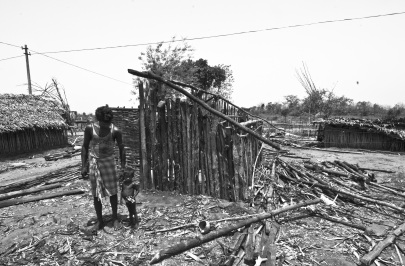
Kovasi Seema with his son Nagesh stand before
the remnants of their home.
In the village of Chalampalam, the Muria claim that it were the ‘Dorlawalla’ who had called the Forest Department to break their homes. While the Dorla from the neighbouring village of Simalpad support the Muria in Chalampalam, the Dorla from Murmuru village do not. Historically it has been the adivasis who protect the forests, and now they are protecting it from the adivasis who’re starving.
In the 22 homes in Chalampalam, almost all the villagers take money from the Dorla to feed their families in the months where they have no work. They will take money from the Dorla or the non-tribal landlords, and during the ‘mirchi’ cutting season, they will work for lower wages to repay the debt. For instance, the regular price for wage labour would be Rs.60 or Rs.70, yet they’d work only for Rs.50. This is a widespread practice in Khamman district.
‘We’ve offered some Gotti Koya Rs.100 to work under the NREGS,’ Said MPDO, Srinivas Rao, ‘But they are very sincere people, they’d still work for Rs.50 for the locals to repay debts.’
In Chalampalam, Madkam Ganga’s house was broken by the Forest officials and Rs.500 was allegedly stolen. He is unmarried and has no children and lives alone. He points out to the small tuck box where he kept his money, and then locks the box. He only started to lock the box after he lost his money.
Kovasi Seema s/o Devaiya also claims that the Forest Department stole around Rs.1000 from his home. He has a one year old child, Nagesh.
Madkam Hidma s/o Dima is a cripple. The forest officials dragged him out of his house before tearing off the roof of palmera leaves. His two daughters, one 18 years old and another 12 years old, and his wife Laxmi, are the only ones in his family who can work.
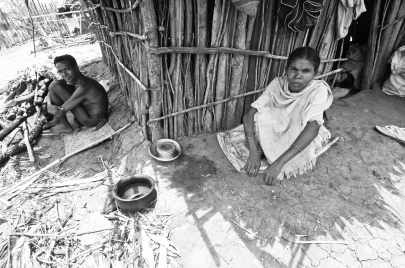
Laxmi Madkam’s husband Hidma is a cripple.
He was dragged out of his house at Chalampalam
by Forest officials who then vandalized their home.
‘We all have problems with food,’ said Kovasi Hoonga, who said that even three cows have died in his village from lack of feed.
Then there is another aspect of Muria life – they refuse to drink cow’s milk.
‘Why don’t you drink cow’s milk?’
‘If we did, there’d be nothing for the calf.’
In fact, the Muria would rather starve than drink cow’s milk, at the same time, they secretly cut down trees in the hope of cultivating enough land to feed themselves but are hampered by the Forest Department. Back in Kamantome I had asked the Muria about the allegations of the Forest Department – ‘The forest department thinks that if given the chance, the Muria will cut down all the trees.’ I said.
‘If we did, then where would we live?’ They replied.
‘We need a policy change,’ Says DFO Shafiullah, ‘These people need to be rehabilitated.’
The Invisible Drought
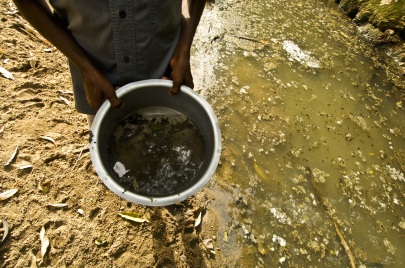
One of the two sources of water
for the villagers of Kamantome.
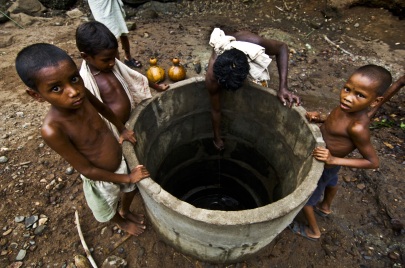
The only source of water for the IDP settlement of
Chukalpar had dried up this year. There was slight
reprieve for the IDPs due to rains caused by cyclone Laila.
In the village of Chukalpaar in Chintur Mandal of Khammam, there are over 28 families who have no voter cards, no handpump, no electricity, no NREGs and they survive by getting ration from Chhattisgarh. Their only source of water for the last five years has been a small rivulet that dries up in summer. They then dig a well into the riverbed for water. But this year, their wells dried up and they started to walk two kilometres in the 46 degree sun to get water from the village of Edugurrallapalli. Then it rained for three days thanks to cyclone Laila. It filled up the little wells in the riverbed but the villagers know it will all dry up in another week. The monsoons, they think, shall only come to them in a month.
In the revenue villages of Pungutta and Amdalpeta in Paiga Panchayat of Chintur, their only hand pumps ceased to work. The villagers had complained to the Mandal Development Officer but their handpumps haven’t been repaired yet. Now they are all dependent on water dug out from the riverbed, or handpumps in the next village that are over 2-3 kilometres away.
Boringudem isn’t named so because there is a handpump or a boring in their village, it is named so as a majority of the villagers in the village work in Vijayawada as labour for a company that specializes in digging borewells. While they receive a decent amount of money – around Rs.5000 that covers their food expenses, their village has no handpump and no boring.
In Kotthur village that is directly adjacent to the main Chintur road, the villagers get water from a small ‘nalla’ or stream nearby. They complain the water tastes terribly foul and that they have no handpump either.
In Dehiyalaware in Paiga Panchayat in Chintur there are over 26 homes that have existed for the last 12 years. There are no IDPs in this village who have escaped the Salwa Judum-Maoist conflict, but mostly migrants hoping for land even though all their ‘patta’ (title) applications have been rejected. ‘We don’t let them come live with us, we know there’d be problems if they came here.’ Said one villager who refused to be named.
Their village has no handpump either and the villagers walk a kilometre to get water from a well dug into the dry riverbed.
‘Is it difficult to sleep at night in this heat?’ I asked.
‘Very difficult, it’s almost impossible to sleep in this heat.’ He replied, ‘We go to the river and take a bath and try to sleep as our bodies feel cooler. But by the time we walk back home, it’s hot again.’
‘Why don’t you just sleep next to the river then?’
He laughed.
‘There are lots of police in this area and if they find us near the river they might think we are Naxalites and take us away or kill us.’
Photography Post-Script
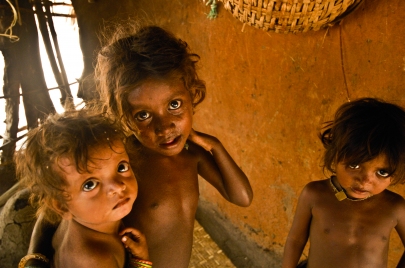
Laxmi, Parmila and Anita. The three infant daughters of
Madvi Hidme of Kamantome village.
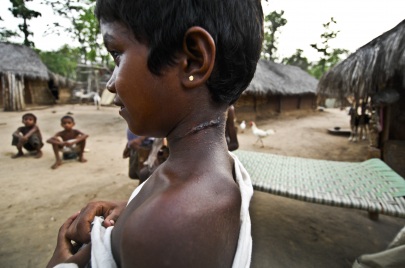
Rawa Devi (6) of Chukalpaar village suffers from
Pyoderma, a bacterial infection.
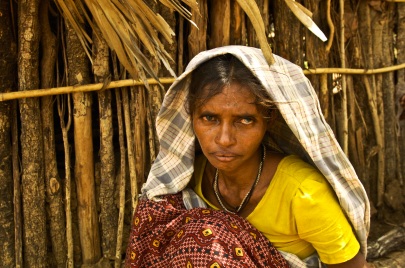
Widow Padan Hoongama, of the IDP village of Challampalam
that was torn down by the Forest Department.
This article first appeared in The New Indian Express on the 6th of June,2010.

